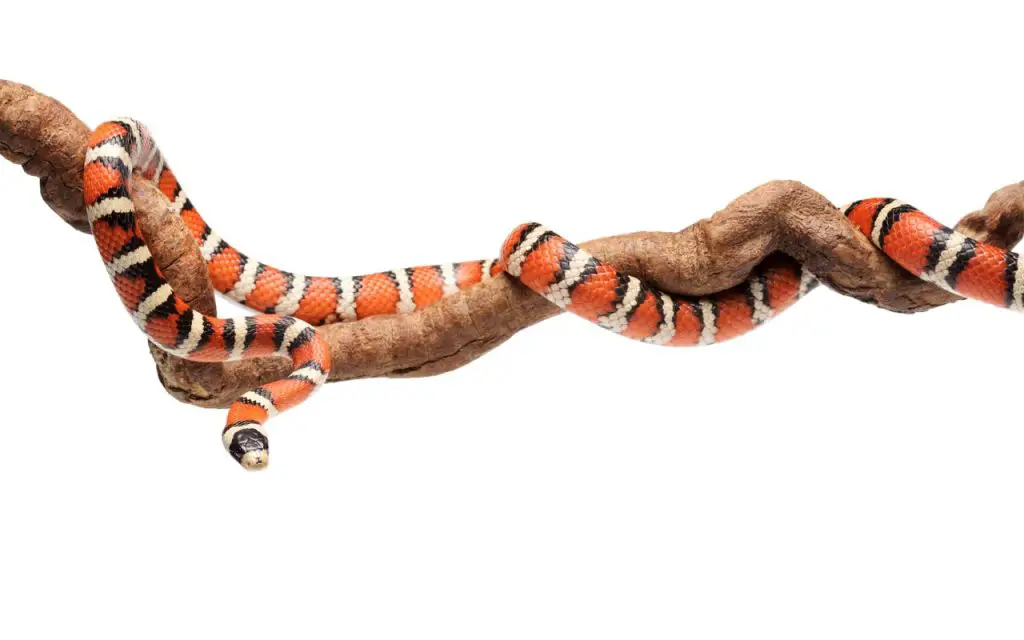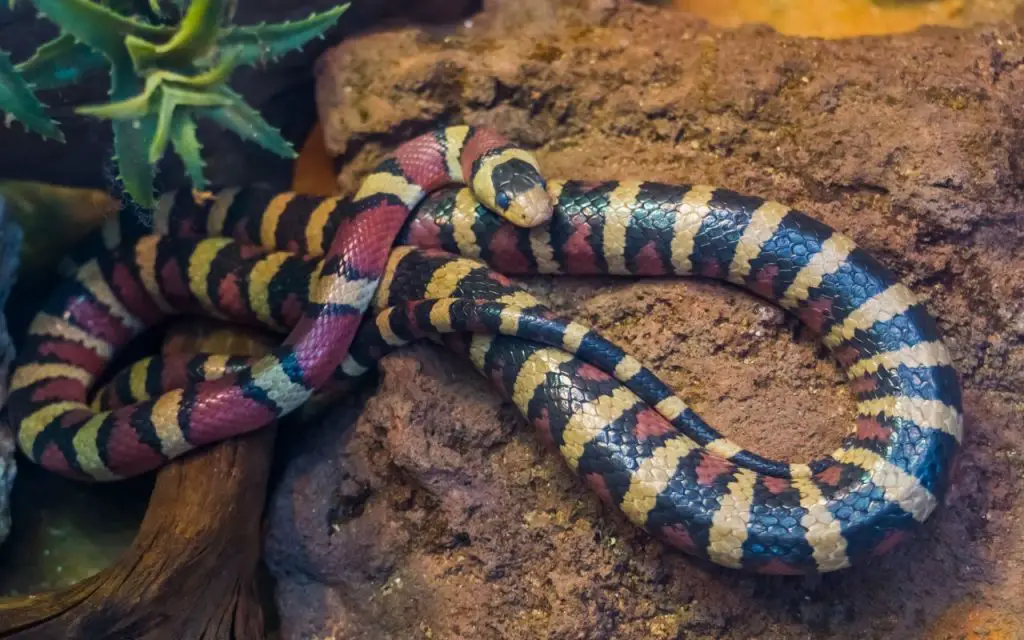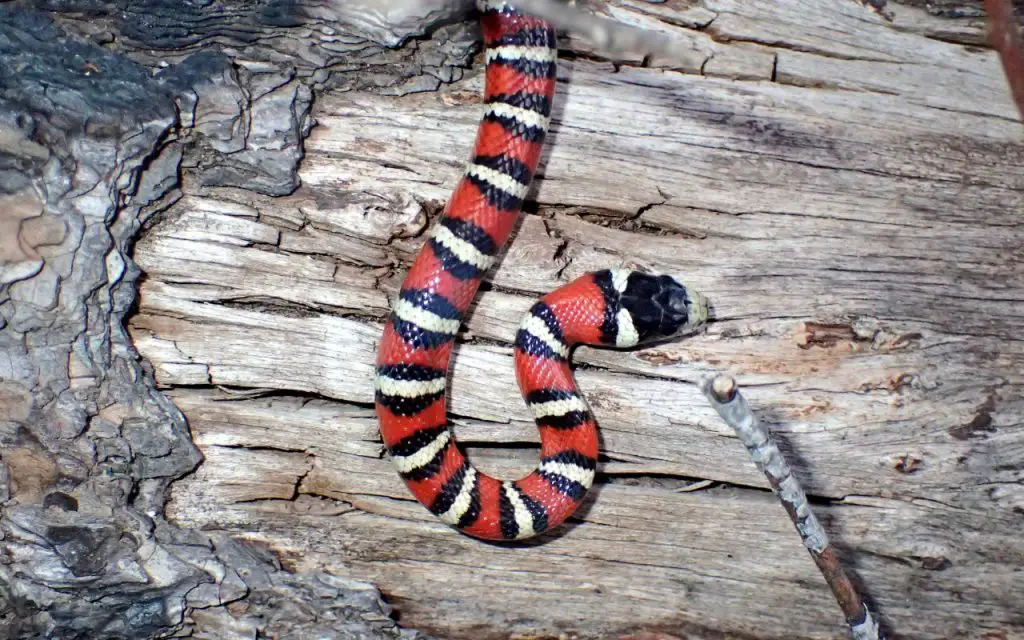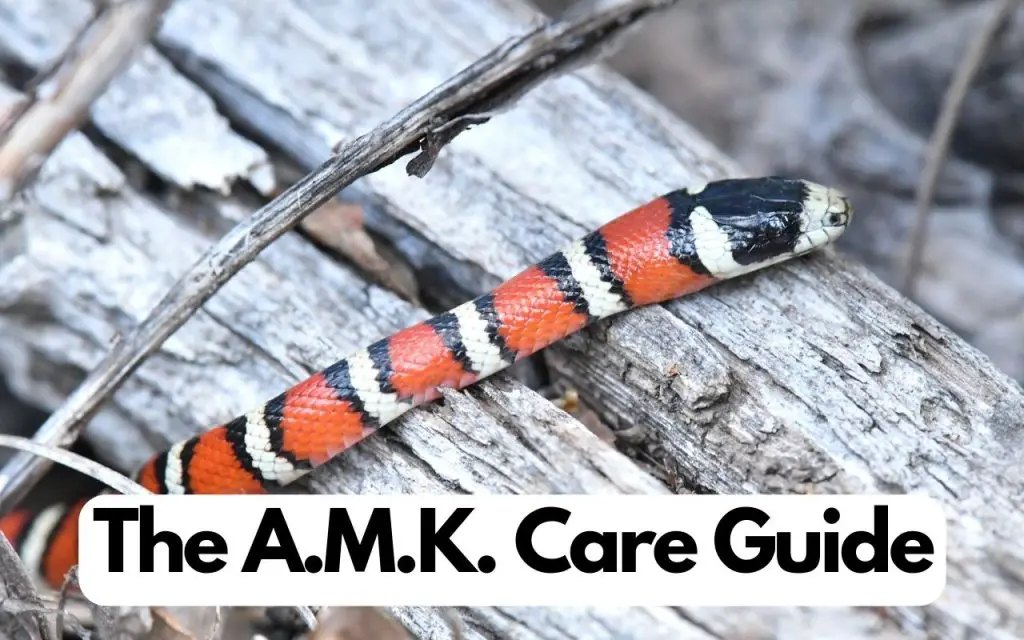I’ve always had a fascination with tri-colored snakes , and among the different species I’ve had the privilege of caring for, the Arizona Mountain Kingsnake holds a special place in my heart. These reptiles are captivating creatures, stunning in their appearance and intriguing in their habits.
Today, I’m thrilled to share my experiences with the Arizona Mountain Kingsnake – focusing on their lifestyle, habitat, and the primary elements required for their care. Let’s dive in…
Arizona Mountain Kingsnake Range and Facts
The Arizona Mountain Kingsnake (Lampropeltis pyromelana) is a small, brightly colored snake native to the Southwestern United States and possibly Northwestern Mexico. Its vibrant banded pattern of red, black, and white rings makes it an eye-catching pet for herpetology enthusiasts.
Although they can be found at various elevations, they’re predominantly high-altitude reptiles, often inhabiting pine-oak forests and rocky mountainous areas. They are non-venomous constrictors and are known for their relatively docile nature.
Despite the fact they sometimes diurnal, you almost never see these snakes out and about. They’re secretive, and tend move from cover-to-cover, even when foraging. Tree bark, logs, and large, flat rocks seem to be some of their favorite spots.
Housing
Getting the right enclosure is a crucial part of Arizona Mountain Kingsnake care. It needs to be the right size, and ensure adequate ventilaition, given how dry their natural habitat is.
Adult Kingsnakes need a terrarium or vivarium of at least 20 gallons – they’re active snakes and require space to move. Younger snakes can be housed in 5-gallon enclosures but remember, they will outgrow this quickly.
I use an Exo Terra glass terrarium with a mesh top to ensure ventilation. I use this brand because I like the design. The terrariums are secure, but have great ventilation for desert and semi-arid species like Mountain Kingsnakes.
Alternatively, you can also modify plastic tubs, and this does work. Just be sure to add plenty of breathing holes so the humidity doesn’t get too high (more on this in a moment).
As with the California Kingsnake, it’s important to remember that this species is cannibalistic – never house them together.
Substrate
Choosing the right substrate is critical for the Kingsnake’s health. I recommend using aspen chips, newspaper, or reptile carpet. Avoid using substrates like sand or pine/cedar shavings as these can cause impaction and respiratory issues.
The substrate needs to be spot-cleaned regularly (I do it as soon as I noticed a mess), with a full change every few weeks to maintain cleanliness and prevent the growth of bacteria.
Bear in mind that using aspen chips makes spot cleaning very easy. Chips are also better than shavings when it comes dust, so I won’t definitely recommend these if you can get them.

Temperature
Kingsnakes, like all reptiles, are poikilothermic, which means they depend on their environment to regulate body temperature. A good temperature gradient for an Arizona Mountain Kingsnake ranges from a warm end of around 85°F to a cooler end of 70-75°F.
Heat can be provided using under tank heaters or heat lamps, but remember to always use a thermostat to prevent overheating. Also, if you opt for a heat lamp, it must be placed above the lid of a mesh-lidded enclosure, or inside a cage when used with a melamine/PVC vivarium.
Never place the heat source in the middle of the tank; always place it at one end to create a heat gradient. This allows the snake to thermoregulate, moving between the warm and cooler ends as necessary.
When it comes to using a thermostat, be sure to choose the right one for your heating method:
| Heating appliance: | Type of thermostat needed: |
| – heat mat | – pulse-proportional or on/off |
| – heat lamp | – dimming |
| – ceramic heat emitter | – pulse-proportional |
| – reptile radiator | – pulse-proportional |
Lighting
While Kingsnakes don’t require UVB light like some other reptiles, a regular day-night cycle is beneficial for their wellbeing. I use a simple naturalistic light setup to mimic a 12-hour day-night cycle.
Humidity and Water
Arizona Mountain Kingsnakes thrive in moderate humidity levels of around 50%. Too much humidity can lead to respiratory issues, while too little can cause shedding problems. I maintain humidity levels ensuring the water dish is always full.
If my Kingsnake is getting ready to shed and the hygrometer in the enclosure reads less than 50%, then I’ll spray with a water bottle.

What do Arizona Mountain Kingsnakes eat?
These snakes are carnivores, primarily feeding on rodents in the wild. They also eat other snakes (even of their species), lizards, and nestling birds.
In captivity, they can be fed a diet of appropriately sized frozen-thawed mice. The size of the prey should be roughly the same width as the widest part of the snake’s body.
Handling
Despite their docile nature, it’s important to handle Kingsnakes with care and respect. Allow them to move freely through your fingers without restricting them.
Regular, gentle handling helps them become comfortable with human interaction. However, avoid handling during shedding periods or right after feeding.
Common Health Problems
Some health issues can arise if Kingsnakes are not properly cared for. These include respiratory infections, parasites, shedding problems, and more. Regular vet check-ups are crucial in maintaining their health.
The table below provides a summary of common health issues:
| Health Issue | Symptoms | Prevention |
|---|---|---|
| Respiratory Infection | Wheezing, excess mucus | Maintain correct humidity, avoid drastic temperature changes |
| Parasites | Weight loss, abnormal feces | Regular vet checks, maintain cleanliness |
| Shedding problems | Incomplete shedding, dry patches | Maintain correct humidity, provide shedding aids like damp moss |

Lifespan
In the wild, Arizona Mountain Kingsnakes typically live for 10-15 years, but in captivity, with proper care, they can live up to 20 years or more. Personally, I think it is unusual for one of these snakes to live less than 10 years as a pet, and I’d be dissapointed if mine didn’t make it to at least 12.
As with all reptiles, heat and hygiene play a huge role in how long they live, and how susceptible they are to illness. If your snake gets great husbandry which meets these parameters well, then it is much more likely to make it to 20 years of age.
Arizona Mountain Kingsnake for Sale
If you are considering getting an Arizona Mountain Kingsnake, do ensure to buy from a reputable breeder. Look for snakes that are alert, have clear eyes, skin, and nostrils, and display no signs of respiratory distress.
Your best bet for finding one is by heading over to Morphmarket.com. Breeders on the site are subject to customer reviews, so you can easily see if they are reputable.
Arizona Mountain Kingsnake Final thoughts…
Caring for these snakes has been an absolute joy. From their stunning appearance to their intriguing behaviors, the Arizona Mountain Kingsnake is a testament to the beauty and diversity of the reptile world. By adhering to the care practices discussed here, you can provide a healthy, enriching environment for these extraordinary reptiles.
Why I like this species:
- Their markings are exceptional
- Most of them never get over 3 feet in length – making them easy to house
- They are docile and easy to handle
Things to consider:
- Finding them for sale can be hit-or-miss, and they are still more expensive than California Kingsnakes or Corn Snakes

FAQ related to Arizona Mountain Kingsnake husbandry
How big does an Arizona mountain kingsnake get?
The largest Arizona Mountain Kingsnake was 42 inches long. That said, I’ve never seen one that size in real life. In general, they seem to be 24 to 36 inches long, with the females being a little larger than males. This is a very convenient size for a pet snake. They’re not tiny, but not larger enough to require a huge enclosure either.
What size enclosure for Arizona Mountain Kingsnake?
The enclosure should be at least 24 inches long for an adult. For a glass tank, this usually means around a 20 gallon capacity. When is comes to vivariums, the Exo Terra “Natural Vivarium” is a good choice, which is available in a 24 inch size.
What temperature do mountain king snakes need?
Because they’re from montane regions, mountain Kingsnakes don’t need temperatures to be quite as high as some other species. They seem to be most comfortable with a warm end temperature of 85F, and a cool end temperature of 75F.
Are king snakes hard to take care of?
King Snakes are not hard to take care of, they are in fact incredibly easy. You just need to get their heat and humidity right and you won’t have any problems. The only real issue with them is that they are cannibalistic – you can never house more than one together.

